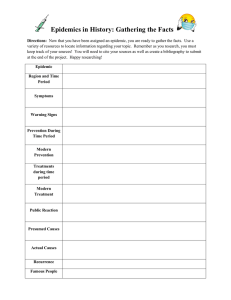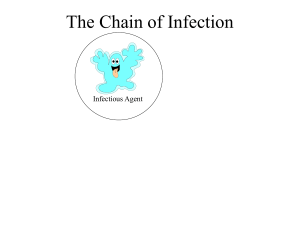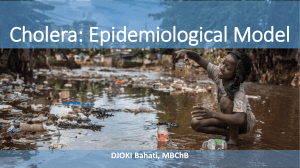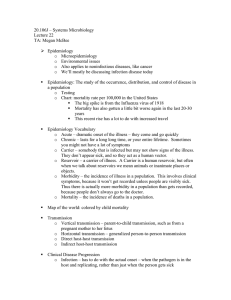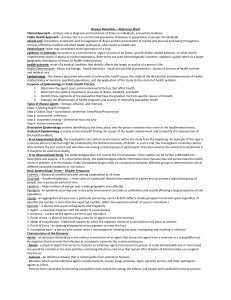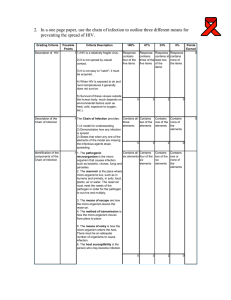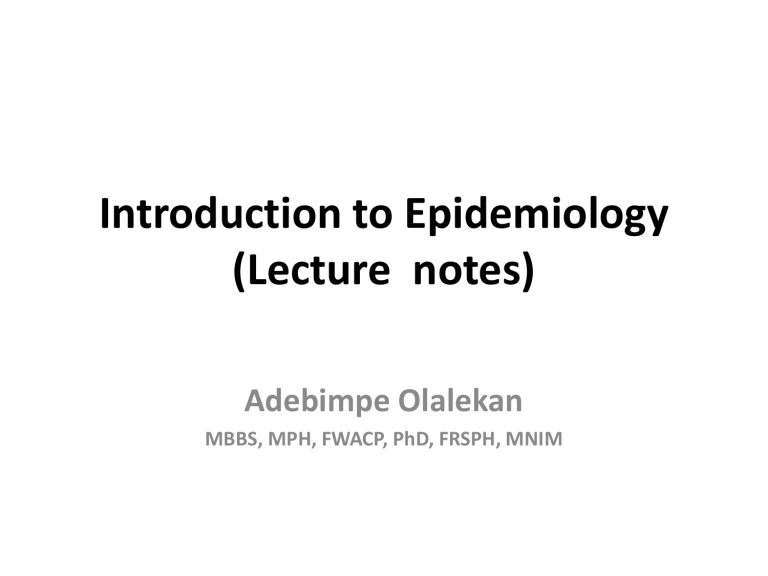
Introduction to Epidemiology (Lecture notes) Adebimpe Olalekan MBBS, MPH, FWACP, PhD, FRSPH, MNIM Contents • • • • • Concept of Health and Disease Infectious disease epidemiology Disease prevention and control Disease screening Epidemics investigation NB: This is a summary note to compliment your reading. It does not in any way replace your lectures, class notes, textbooks or other learning materials. Concept of Health and Disease Definition of Health • WHO defined health as a complete state of physical, mental and social well being and not just the absence of disease or infirmity, leading to an ability to lead a socially and economically productive life • Health cannot be a state. It should be dynamic? ….a continuum- which changes as indices of life changes • Health cannot be measured by this definition • The concept appear broad, and relegated the environment Concept of Health • Biomedical concept: based on absence of disease. However the importance off the environment is relegated • Ecological concept: based on dynamic equilibrium between man and his environment. However, a perfect man or perfect environment rarely exists • Psychosocial concept: Man’s socioeconomic indices determines his health including what he can afford or access, his politics, culture etc • Holistic concept: combines all above Determinants of health • Health in the middle • Individual, family and communities surrounding ‘Health” • The various determinants surrounding: – – – – – – – – – – Biological/genetic Social Cultural Economic Access to health services Gender Environmental Genetic Nutritional etc Concept of well being • How well you are incorporates 2 components • (1) Objective concept= standard of living: your expenditure, income, occupation etc • (2) Subject component : Quality of life=condition of life resulting from the combination of effects of factors that determines your health, or how individual, or group perceive their physical, mental and social well being – Physical Quality of Life Index (PQLI): consolidates 3 indicators- literacy rate, life expectancy at one, and IMR – Human Development Index: longevity Spectrum of health Evidence to show that health is not static Positive side • Positive health • Better health • Freedom from sicknesses Negative side • Unrecognized illnesses • Mild sickness • Moderate sicknesses • Severe sicknesses • Death Indicators for health • How healthy is a community? Needs measurements • Indicators are thus required • Qualities of indicators: valid, reliable, sensitive, specific, feasible and relevant • Types of indicators: mortality, morbidity, disability, nutritional, health care delivery, Health utilization, environmental, socioeconomic, health policies, indicatprs of quality of life, etc • Assignment: – Give 3 examples each of these indicators – Categories and list 10 indicators used to monitor progress towards Health For All(HFA) – Elaborate the provisions of MDGs Vs. SDGs Ecology and dimensions of health Ecology • Mans total environment – Biological: living things- man and animals – Physical: Non living things – Psycho-social: customs, laws, religion etc • As man alters his environment, he creates more problems for himself informed by interrelations among the different components Dimensions of health: Physical Mental Spiritual Emotional Vocational Social Concepts of disease • Illness…..sickness….disease all not the same • Theory of Disease causation – – – – – – Supernatural theory: sin against God Spontanous generation Humors Miasma Germ: agent=sole cause of disease Epidemiological triad: agent, host and environment • Multi-factorial causation – Disease is due to multiple factors contrary to the idea of germ theory – Applied more to NCDs-risk factors • Web of causation: use MI as example Iceberg phenomenon of disease • Many cases of illnesses not recognized, not reported and therefore remain hidden • Many cases – Self treatment – Treatment by traditional healers – Treatment by quacks • Only few cases(the tip of the icebergs) got reported • This necessitates screening, case finding, contact tracking and other epidemiological approach INFECTIOUS DISEASE EPIDEMIOLOGY Definition of terms • Assignment: Define and elaborate on the following terms – Infectious disease Contagious disease – Epidemic: in excess of expected occurrence – Endemic: constant presence within a geographical region – Sporadic: scattered, irregular, few cases, haphazardly, from time to time – Pandemic: epidemic now spread worldwide e.g HIV – Exotic: disease imported into a country in which they do not otherwise occur e.g rabies in UK – Zoonoses: diseases of animals transmitted to man • Anthropozoonosis; if from vertebrate animals to man e.g rabbles, plague • Zoonoanthroposis from man to vertebrate animal e.g Human TB in cattle • Both direction: T. cruizi infection – Epizootic=epidemic of disease in an animal population & may eventually affect man e.g rabies, anthrax and Definition of terms • • • • • – Enzootic: endemic occurring in animals: anthrax, rabbles, brucellosis, bovine TB – Nosocomial: hospital acquired infections – Iatrogenic or Physicians induced or causing it – Opportunistic infections Case: could be subclinical cases, latent phase in which host does not shed the infective agent which lies dormant within the host without symptoms. All these are potential sources of infection Primary case=1st Case of a disease Index case-1st case that comes to physician attention, Secondary case= cases propagating from primary case Suspect is someone who have all the signs and symptoms but not yet diagnosed Epidemiological triad • Epidemiological triad : based on the model of – – – – Agent Host Environment Time • Agent: is the cause of disease- viral, bacterial, fungal etc etc • With regards to NCDs: agent could be a chemical (from dietary food, tobacco smoke, solvents), radiation, nutritional deficiency etc • Host: is an organism usually human or animal that harbors' the disease • Environment: surrounding where disease thrives: Physical, Biological and Psychosocial • Time: incubation period, duration of illness, life expectancy of the host or pathogen, severity of illness Agents • Agent: should be able to multiple, emerge from the host, reach and infect a new host. Agents lives and multiple in the reservoir from where it is transmitted to other habitat. Common types include • Biological or infectious agent: Characteristics include – Pathogenicity – Infectivity – Virulence • Nutrient agents: deficiency of any of the components of food leading to PEM etc • Physical agents : health cold, humidity, pressure • Chemical: endogenous (e.g urea, bilirubin etc) or exogenous (e.g allergens, metals and dusts)to the host • Social agents: poverty, alcohol, smoking, drug abuse etc Reservoir • Reservoir or source of infection – It is the ecological niche (person, animal , arthropod, soil etc) in which an infectious agent lives and multiplies and on which it depends primarily for survival and where it reproduces itself in such a manner that it can be transmitted to a susceptible host • Source= person, animal or object from which an infectious agent passes or is disseminated to the host. It may or may not be a part of the reservoir • Animal reservoir: Zoonoses: examples: taeniasis, plague, rabies, • Non living things reservoir: majority are saprophytes living in soil as r tetanus and anthrax Reservoir • Hookworm = Reservoir (man) and the source (soil contaminated with infective larva) • Tetanus: Reservoir and source are the same (soil) • Typhoid: reservoir is the case or carrier, Source is the faeces or urine of patients or contaminated food, drinks or • Reservoir can be a living (man or animal) or non living thing Man as reservoir, Carriers CARRIERS • Due to inadequate treatment or immune response, the infectious agent might not be completely eliminated, leading to development of a carrier state. • A Carriers is an infected person or animal which harbors the infective microorganism , but shown no signs or symptoms but have the capability of transmitting the disease from one person to the other. • They are less infective, but more dangerous as they can infect large people over a wide area. Example=typhoid Mary • They shed the infective agent in the discharge of excretion or discharges, and acting as source of infection for other patient. • Carriers may outnumber the cases, Carriers cont…… • Types of carriers – incubatory(measles, mumps, polio, pertusis, diphtheria, Hepatitis B) – convalescents(typhoid, dysentery, cholera – Healthy (victim of subclinical disease acting as a carrier) polio, cholera, meningitis, salmonella, diphtheria). They are not sick so can easily infect others without taking caution • Duration: – Temporary carriers (e.g ICH), – Chronic(typhoid, hepatitis B, CSM, malaria, gonorrhea. They do introduec infection to free areas, so should be controlled early • Portal of exit of the infections agent: – urinary, – intestinal, – respiratory Host/environment • Host creates lodging or subsistence for the agent • Host factors include: – – – – – Demographic: age, sex, race Biological such as genetic make up, blood groups, Socioeconomic factors; education, occupation, housing Lifestyle factors: personality traits, living habit, exercise etc Others: level of immunity, overall fitness, state of health • In NCDs: we talk about risk factors, not the agent: It is an attribute or exposure that is significantly associate with development of a disease • Assignment: List the common risk factors associated with common NCDs in Nigeria • Environment: Physical, Biological, social Transmission dynamics Common modes of transmission • • • • • • Faeco-oral/ingestion Respiratory tract/Airborne Contacts- skin and mucous membrane Transplacental Vehicle borne Vector borne Susceptible host • Portal of entry • Site of multiplication • Portal of exit Transmission dynamics Incubation period IP • Defined as the period between agent invasion to appearance of 1st symptom/sign • IP vary with disease and individuals • There is usually a minimum IP for all disease before which no clinical case occur • Medium IP= time for 50% of the cases to occur • Secondary cases may occur, leading to prolonged/maximum IP • Latent period=IP in NCD=interval between disease initiation and detection, and usually long • IP assist in tracing source of infection and contacts,- most especially diseases of short IP such as Gonorrhoe: cases control involves tracing sexual contacts in the last 5 das(the IP) • IP is used in determining the period of surveillance and quarantine. • Other uses of IP: Immunization, Identification of point or propagated source epidemics. Transmission dynamics Prodromal period defined as the interval between onset of symptom and appearance of pathognomic or characteristics clinical signs e.g measles….. 10 days for fever and cough to appear= IP Next 4 days for the characteristics measles rash to appear= prodromal period • Assignment: List 20 common disease and their IP • Write short notes on – period of communicability – generation time – secondary attack rate Natural history of disease • Interaction of the contents of the triad determines occurrence or otherwise of a disease • Natural history of a disease is the evolution of disease over time, from the earliest stage(pre-pathogenesis) to the disease stage(pathogenesis) to recovery, disability of death(late pathogenesis stage) • Its unique for each disease, even different individuals • Pre-pathogenesis- disease process favours the agent- it reflects the …..epidemiological triad. Level of prevention is primary, and mode of intervention=health promotion and specific protection • Pathogenesis stage: .various clinical presentations are already occurring. The levels of prevention=secondary and tertiary while mode of intervention=early diagnosis and treatment, disability limitation and rehabilitation Disease Control • Objectives – Reduce disease incidence and prevalence – Reduce disease duration and risk of transmission, – Reduce complications or consequences and financial burden on the community • Community participation, political support and intervention coordination required • John snow controlled cholera epidemic in London by removing the handle of the incriminated water pump • Strategic control targets: include • the reservoir of infection, route of transmission and the susceptible host Disease control • Disease control usually leverage on primary and secondary prevention • Disease agent is permitted to persist in the community but to a level that its no more of Public Health importance • Concepts in disease control – Disease elimination: means interrupting disease transmission, it’s a goal between control and eradication. Common disease targeted for elimination include polio, measles and diphtheriaregionally and over a large surface area – Disease eradication; Extermination of the infectious agent from the whole world. It is a all or none phenomenon.. 3 diseases targeted for global eradication include polio, measles and guinea worm. • Smallpox successfully eradicated Control Methods Eliminating reservoir of infection Controlling or eliminating reservoir of infection • Early diagnosis and treatment • Disease notification to the local health authority. However certain disease are notified by the national health authority to the WHO- 2 categories • (a) Diseases subject to International Health Regulations (1969):Cholera, plague and Yellow fever • (b) Diseases under WHO surveillance: polio, malaria, smallpox, SARS, influenza, louse-borne typhus fever, relapsing fever Eliminating reservoir of infection • Epidemiological investigation during disease outbreak • Isolation: defined as separation for the period of communicability of infected person or animals (from those susceptible. Types of isolation include – Standard isolation, strict isolation, protective isolation, and high security isolation – Common scenarios-Diptheria, cholera outbreaks – Diseases with subclinical state or carrier stage are difficult to isolate, such as polio, typhoid, Hepatitis A – Highly infectious disease(before diagnosis) such as mumps, (physical rather than chemical isolation) and leprosy and STI are difficult to isolate Isolation cont….. – For some diseases, isolation is better in homes than hospitals- better in homes • Isolation; indicated in disease of – high mort and morbidity – High infectivity – No significant extra-human reservoir – Infection with easily recognizable cases – Chronic carriers are not significant part of the reservoir • Assignment: List the period of isolation of the folowing disease- measles, chicken pox, Polio, TB, Mumps, peruses, Hepatitis A and Diphtheria Eliminating reservoir of infection • Quarantine- It is the limitation of freedom of movement of well persons or animal for a period of longest incubation period, thus protecting the exposed’. It also applied to means of transportation such as aircraft, ship- all could be quarantined • Treatment- using drugs. Individual or community can be treated. Types – – – – Mass chemotherapy Selective Targeted High risk Interrupting disease transmission • The approach is to the deal with the mode of transmission • Water borne disease- water treatment • Food borne disease-improved hygiene- handwashing, cooking, etc • Vector borne- vector control and its breeding sites • Respiratory- controlling droplets , dust etc Protecting the susceptible host • Active immunization: augments herd immunity thus making the infection more difficult to spread NPI • Passive immunization: short tem, used when infection is imminent or just occurred, . Duration of immunity conferred is short. 3 types – Normal human immunoglobulin – Specific human immunoglobulin – Antisera or antitoxins • Chemoprophylaxis: drugs protecting from or preventing disease, thereby eliminating the causal agent or clinically(preventing the clinical symptoms) • Assignment: List the chemoprophylaxis- for cholera, diphtheria, malaria, plague and meningitis What’s next after control • Surveillance – Define as continuous watchfulness over the course of a disease through data management and feedback informing policy decisions – Objective: to gather information on new and changing trend of health of a population –mortality, morbidity – To provide feedback that could inform policy decisions – To provide warning signs that could herald Phublic Health interventions • Surveillance define the disease , lab diagnosis, identifying source of infection, mode of transmission, contacts, and those at risk; then reporting, the tools, IDSR, challenges • Finally= data consolidation, interpretation, dissemination of info to those in charge of control • Types of surveillance : Local, national, international, individual or sentinel sites surveillance IDSR, surveillance tools, components, methods and challenges Concept of prevention • Objectives: To use natural history or epidemiology of disease to promote and preserve health, restore health when impaired, and minimize suffering and distress • There are 4 levels of prevention – Primordial level: New concept, more related to NCDs. It includes the prevention of development of risk factors among countries or population groups where they are not yet appeared e..g Hypertension and obeisty in children – Primary level: action taken prior to onset of disease which removes the probability of a disease occurring. Methods of primary prevention include (a) health promotion and (b) specific protection. The strategy include mass/population or high risk strategy Levels of prevention – Secondary level: action that could halt the progression of an ongoing disease and prevents complications. Strategies include (a) early diagnosis through screening and case finding for treatments. This strategy is rather imperfect, more expensive. Its more related to clinical medicine and most efforts of governments. Its less effective than primary prevention – Tertiary level= activities in the late pathogenesis stage- limitation of disability and rehabilitation Primary prevention • What level of prevention are these activities? – – – – – – – – Sanitation Infection control Protection of food, milk and water supply Protection against occupational hazard and accidents Basic personal hygiene Hand washing Refrigeration of food Waste management Modes of Intervention • 5 Modes of intervention – Health promotion: health education, environmental modification (e.g provision of safe water, latrine, insect vector control and rodents control, improved housing), nutritional interventions (such as food improvement for the vulnerable, food fortification, nutritional education, child feeding programmers), lifestyle modification(avoid alcohol, smoking, sedentary lifestyle, junk foods etc) – Specific protection: immunization, use of specific nutrients, chemoprophylaxis, protection against occupational hazards, carcinogens, accidents – Early diagnosis and treatment: not really prevention but it is – Disability limitation – Rehabilitation Disability/Handicap • Disease…..impairment….disability….handicap • Impairment=abnormality or loss of anatomical or physiological or psychological structure or function e.g loss of a foot • Disability=due to impairment, there is inability to carry out certain activities considered normal for that age, sex; e.g cannot walk • Handicap = due to disability, one is disdvantaged in life and cannot cope with social responsibility expected of him e.g unemployed Rehabilitation • Rehabilitation – Define as combined and coordinated use of medical, social, educational and vocational measures for training and retraining of individual…. To the highest possible level of functional ability – 4 types: medical, educational, vocational, pschosocial – Example= establishing school for the handicapped, provision of aids for the crippled, reconstructive surgery for leprosy clients Disinfection • Disinfection is the thermal or chemical destruction of pathogens and other types of microorganisms. • Sterilization is the process of rendering a product free of all forms of microorganisms including bacterial spores. Its more lethal than disinfection • Disinfectant Vs. sterilizer • An ideal disinfectant should be broad spectrum, fast acting, non toxic, surface compatible soluble in water, easy to use and should leave a residual behind on treated surfaces. • Types of disinfection – Concurrent: as soon s possible after discharge of secretions etc Sterilization cont…… – Terminal: after death or transfer out – Prophylactic: such as hand washing, chlorination of water, pasteurization of milk • Sterilization methods Natural agents: sunlight, Air • Physical agents – Burning or incineration: for contaminated dressing, swabs – Hot air: Glass ware, syringes, swabs – Boiling(for about 10 minutes): kills bacteria but not spores or viruses. It is good for sterilizing instruments, tools Sterilization cont…. – Autoclaving: sanitation of linen, dressing, gloves, culture media etc. its highly effective and destroy all organisms – Irradiation: ionizing radiation or sterilization of bandage, dressings and surgical instruments, but expensive • Chemical: Phenol, Ammonium, Halogens, alcohol, formaldehyde, ethylene oxide • Others – Ozone, – UV radiation, – Pasteurization(of milk” up to -70c for 3o minutes to kill all microorganism but not the spores – 5% bleaching powder – 10% formalin Immunity Immunity • NON SPECIFIC – – – – – – • • • Skin covering Mucus membrane- tears, gastric secretions, Nasal –Cilia Sneezing and coughing reflex Gastric acidity ETC SPECIFIC: Active or passive Active:Humoral or cell mediated Humoral: Following infection or foreign body or immunization---production of antibodies – Primary response= B cells responded: IgM, rise and falls, then IgG after few days---plasma cells: production of enough mop up antibodies – Secondary---memory cells--- stimulates plasma cells----antibodies. All above=humoral. • • Cell mediated: WBC-Lymphocytes- T cells: various types - use HIV as example Passive: here pre-formed antibodies produced by one person or animal are introduced into another to induce protection. This ready made antibodies could Immunity cont…. • This come in different ways. • (a) introduction of antibody containing preparation :Human immunoglobulin(normal and specific) • Animal antitoxin and antisera • A traveler going to highly endemic area may wish to receive Hepatitis Ig • (b) trans via placenta from mother to child HERD Immunity=community immunity some immune individuals transfer protection to the exposed • The higher the herd immunity, the less the infection thrives • HI provides immunological barriers to disease spread • Introduce a disease to a virgin population( with no or fewer cases), cases and fatality rise initially then decline as HI spreads • HI depends on number of case/subclinical, immunization, the ever changing herd structure Brainstorming…… • Developed world have conquered Communicable diseases • Some reasons why developing world is yet to conquer – Poverty, sanitation, uncontrolled urbanization, mass movement, population growth, poor access to health services lack of political will, poor community part and actions – New diseases emerging, some already controlled reemerging – NCDs increasing Disease screening Screening • The concept of the iceberg phenomenon reflects numerous hidden cases of illness of disease • Consider a apparently health population • A disease X of Public Health importance can be screen by a simple, inexpensive, easy to do, simple technology, accurate and accessible test that could divide the population into those who are positive and those negative. Only the positive ones are further subjected to a confirmatory test • Screening- is done on apparently healthy, groups of people, test results are arbitrary and final, but less accurate, less expensive, not a basis for treatment,. The imitative comes from investigator’ • time lag between disease onset and time of diagnosis is there, yet a time is gained from this time of diagnosis to the time of usual diagnosis of that disease. This is the lead time gained by screening Screening cont… Uses of screening – Case detection – Disease control – Research Types – Mass – High risk or selective – Multi-phasisc Screening criteria Criteria: the disease • Disease must be of public health importance • There should be a recognized latent or early asymptomatic stage • Variations is minimal: technical, biological (both intra and inter observer variations) • There should be a way of confirming screening result • There must be a way of treating the disease • Natural history of disease must be known The test • Acceptable, accessible and affordable • Nil or negligible false positive or false negative • High validity and repeatability • Consider the 2 by 2 contingency table below Disease present Disease absent Screening test positive a (TP) b (FP) a+b Screening test negative C(FN) d(TN) c+d Total a+c b+d a+b+c+d • Outcomes-True positive TP, True Negative TN, false positive FP and False negative FN • Borderline and false results are threats Measurements and evaluation • Define the following – Sensitivity Ss= a/a+c X100, – Specificity Sp= d/b+d X 100 – Proportion of False positive= b/b+d X100 – Proportion of False negative= c/a+c X 100 – Positive predictive value PPV+ = a/a+b X 100 – Negative predictive value PPV-= d/c+ X 100 – Diagnostic accuracy= a+d/a+b+c+d X 100 – Yield = a/a+b+c+d Examples of screening test Common examples of screening test: • Hypertension: Bp measurement • Syphilis: VDRL • Diabetes: Urinalysis • HIV: ELIZA • Cancer cervix: Paps smear • Cancer prostate: PSA • Cancer breast: BSE/mammography • Typhoid: widal test • Malaria: RDT Use the Determine- Unigold- Statpack kits- serial testing algorithm in Nigeria for HIV testing to illustrate screening test. • Assignment: What are the corresponding confirmatory test for the various test mentioned above Epidemics: Introduction • Definition: unusual disease occurrence ‘far in excess’ of what it used to be for that (geographical) region • Types: – Common or point source (single or continuous exposures) – Propagated source(person to person, arthropod, animal vector)--usually of infectious disease origin – Slow or modern epidemics (of NCDs) • In point source epidemic – all cases occur within one incubation period of the disease. – It is usually explosive, with clustering of cases – short lived, with cases climbing up and then falls over time, and no secondary case. The epidemic curve usually have only one peak – Most Characteristics of propagated epidemics are opposite that of point sour – Draw epidemic curve Recent/ongoing epidemics in Nigeria • • • • • • • • Febrile rash illness killed 25 children in Lekki-February 2016 Lassa fever: still ongoing- 101 deaths by April 2016 Ebola Virus Disease 2015 August- Nov- 14 cases, 3 deaths Ondo Ode Irele- alcohol poisoning- 25 deaths Ede Cholera outbreak: 2014/2015 Shaki Cholera outbreak: 2014 Bird flu, SARS resurfaced 2014/2015 Others: Containment was achieved through good political will, coordinated response, stakeholders commitment, community participation, health promotion and a responsive health system Epidemic Preparedness • Establish preparedness and response team: multi disciplinary team • Review disease surveillance systems from time to time • Assess local resources needs • Infection control precautions • Fix early warning signs • Improve DSN/IDSR systems • Obtain strong political will • Health promotion programmes • Step up epidemiological research • Collaboration with animal health services if need be Recent/ongoing epidemics in Nigeria • • • • • • • • Febrile rash illness killed 25 children in Lekki-February 2016 Lassa fever: still ongoing- 101 deaths by April 2016 Ebola Virus Disease 2015 August- Nov- 14 cases, 3 deaths Ondo Ode Irele- alcohol poisoning- 25 deaths Ede Cholera outbreak: 2014/2015 Shaki Cholera outbreak: 2014 Bird flu, SARS resurfaced 2014/2015 Others: Containment was achieved through good political will, coordinated response, stakeholders commitment, community participation, health promotion and a responsive health system Investigating epidemics • Aim is to define magnitude of the epidemic, study its epidemiology and make recommendations to prevent reoccurrence. Steps are: • • • • • • Confirm the diagnosis Confirm existence of epidemic Define and Identify Cases Case Classification: and counting Identify Population At Risk Perform Descriptive Epidemiology: formulate and then test hypothesis on the epidemiological trend • Determine epidemic type • Draw epidemic curve • Develop and evaluate hypothesis Investigating epidemics • Treatment and control measures as investigation continues • Review epidemic data from time to time • Report writing • Information dissemination • Ongoing surveillance Illustrate practically with outbreak of ‘Diarrhoeal’ disease from bacterial food poisoning’ recently reported in a community of 120,000 population
